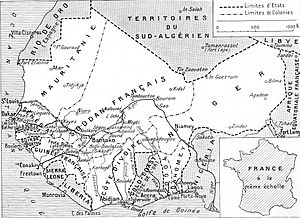French West Africa in World War II facts for kids
During World War II, French West Africa (also known as AOF) was not a main battlefield. Only one big fight happened there: the Battle of Dakar (September 23–25, 1940). This area stayed under the control of Vichy France after France was defeated in June 1940. It remained under their control until the Allied forces invaded North Africa in November 1942.
French Gabon was a colony in French Equatorial Africa. It was the only one that did not join Free France after the war agreement. It was taken by Free French forces from nearby colonies after the Battle of Gabon (November 8–12, 1940). This made French West Africa even more isolated.
The French Colonial Troops in West Africa were not made smaller after the 1940 agreement. The Axis powers did not bother the region much. This meant that when French West Africa later joined Free France, its troops were a valuable addition. Before this, there was some tension between the French and the nearby British colonies, like Sierra Leone. However, no actual fighting happened between them.
The Battle of Dakar
Many people in Africa were angry at the British. This was because the French battleship Richelieu was hit in the port of Dakar, Senegal, on July 10, 1940. Dakar is in French West Africa.
In August, Free French General Charles de Gaulle suggested a plan. He wanted to land troops at Conakry, French Guinea. He believed that people would support the Free French movement as they moved towards Dakar. But the British wanted to act quickly, so de Gaulle's idea was not followed.
On September 18, three French light warships, the Georges Leygues, the Gloire, and the Montcalm, were stopped by Allied ships. They were on their way to Libreville. One of the Allied ships was the heavy cruiser HMAS Australia. The three French warships were forced to turn back.
The Vichy French forces became more determined to resist after these attacks on their ships. The Battle of Dakar took place from September 23 to September 25, 1940. Allied forces first tried to convince the Vichy French defenders in Dakar to let them enter peacefully. They used propaganda messages. When that did not work, they tried to take Dakar by force. Both attempts failed. The Allies' hopes of taking over French West Africa were stopped for a while. This meant that French Equatorial Africa, which was less developed, became the main Free French territory right after the war agreement.
The Battle of Gabon
The Battle of Gabon happened in November 1940 during World War II. Forces led by General Charles de Gaulle fought in this battle. They took control of the colony of Gabon and its capital, Libreville, from Vichy France. This battle helped French Equatorial Africa join Free France. It was the first military action that led to the liberation of France. It was also the only battle of the war fought in Equatorial Africa.
Operation Torch
French West Africa surrendered during Operation Torch to the Allied armies. The Dakar Air Base became a very important air base for the Allies.
See also
- Liberation of France
- Thiaroye massacre


